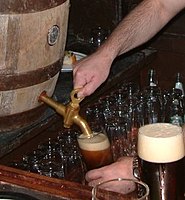
Photo from wikipedia
There are mainly two options for the dealcoholization of beer: evaporation of ethanol by heat treatment, whereby desired aroma-active compounds are also removed, and stopped fermentation that leads to beers… Click to show full abstract
There are mainly two options for the dealcoholization of beer: evaporation of ethanol by heat treatment, whereby desired aroma-active compounds are also removed, and stopped fermentation that leads to beers still containing high amounts of unfermented sugar in parallel with lower amounts of aroma-active fermentation products. Thus, dry-hopping could be an opportunity to compensate these aroma deficiencies. Therefore, following the sensomics approach, odorants were characterized in dry-hopped (Hallertauer Mandarina Bavaria, Hallertauer Cascade, or Hallertauer Mittelfrüh) top- and bottom-fermented alcohol-free beers either after thermal dealcoholization or stopped fermentation. Twenty-three odorants were quantitated via stable isotope dilution analysis and odor activity values (OAVs; ratio of concentration to odor threshold) were calculated. Thermally dealcoholized samples showed high losses (up to 100%) of key odorants like 3-methyl-1-butanol or 3-methylbutyl acetate. During stopped fermentation, aroma compounds like ethyl butanoate or 2-phenylethanol were formed in relevant concentrations, leading to OAVs ≥ 1, but the amounts were significantly lower compared to beers with normal alcohol contents. For hop-derived odorants (linalool, geraniol, myrcene, esters), transfer rates between 20% and 90% were found, leading to OAVs ≥ 1 in beer. Furthermore, hop addition apparently induced the formation of ethyl esters of hop-derived monocarboxylic acids.
Journal Title: Journal of agricultural and food chemistry
Year Published: 2020
Link to full text (if available)
Share on Social Media: Sign Up to like & get
recommendations!